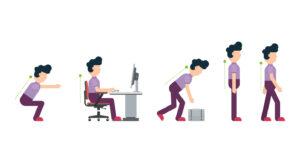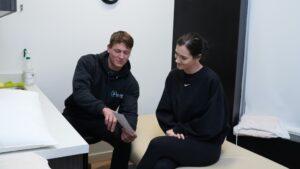
As school is starting up, our children and teens will be sitting more at their desks, hunched over their laptops or textbooks, slouching in their chairs. Back to school season is a great time of year and vital period of growth. Unfortunately, bad posture during peak growing years can strongly influence how your students will look and feel as an adult. Poor posture can lead to, general pain, low back pain, chronic low back pain, and other long-term musculoskeletal conditions. As educators, parents, and of course your local physical therapy clinic, we know it’s vital to emphasize proper posture for young people from a formative age.
To help the students in our lives, let’s first discuss healthy sitting posture. If you sit with very poor posture, you can develop or worsen scoliosis—a leading cause of chronic low back pain—and emphasize kyphosis, also known as a humpback. This can also contribute to neck pain and other long-term medical conditions.
How to sit properly
Good sitting posture starts with moving your sit bones all the way back in your seat. If you have a tendency to sit closer to the edge of the chair, your body will naturally slouch back into the back of the chair or lean forward, causing tightness and pain in your hip flexors. When you go to sit down, think of sticking your sit bones back, as if doing a deep squat, and position yourself all the way back in the chair. Your weight should be on your butt bones (the ischial tuberosities).
Once this is complete, check to make sure your breastbone (sternum) is stacked directly over the top of your pubic bone. These two bony landmarks should be aligned with one another. If the breastbone is behind the pubic bone, you’re most likely slouching, which can quickly lead to low back pain. If your breastbone is in front of the pubic bone, you are most likely bent forward and causing pain and tension by tightening your hip flexors.

You should now be properly aligned with your butt back in the chair and breastbone over the pubic bone. Ideal posture consists of sitting tall through the top of your head, with your chin just slightly tucked. Imagine someone pulling you up by a ponytail on the crown of your head! When you grow tall in your seat, you’ll feel your lower abdominals and the muscles between your shoulder blades contract or squeeze. This helps the correct muscles engage to help stabilize your posture.
This seated position will seem nearly impossible to maintain at first, but as your stabilizer and postural muscles grow stronger, it will get much easier to maintain over long stretches of classroom and work time. Ultimately, properly aligned posture will save you a great deal of low back pain or pain in general for your future self!
Back to School Physio Exercises
These 5 stretches can easily be completed at school or in the office to maintain healthy alignment throughout the day. Prevent pain with these step-by-step physical therapy exercises!
Scapular retraction
Sit with good posture, arms down at your sides.
Bend your elbows to 90 degrees, rotate the arms away from the body, and squeeze the shoulder blades together.
Hold this position for 10 seconds, relax for 5 seconds
Repeat 10-15x.
This exercise shouldn’t cause any neck pain or back pain. Take it slow and stop if you feel any discomfort.
Trunk Rotation
Keep your feet firmly on the ground, facing forward.
Twist your upper body in the direction of the arm that’s resting on the back of your chair.
Hold pose for 10 to 30 seconds.
Repeat on other side.
Exhale as you lean into the stretch for a greater range of motion! This may alleviate or prevent low back pain
Hip flexor stretch
Start standing. (Hold onto a wall if needed for balance).
Bend your knee and grab your ankle behind you.
Draw the heel of your foot toward your lower back. Make sure your knee stays behind your body (not in front of your hip). Squeeze your glute (or buttock) on the side with the bent knee.
Hold for 60 seconds, switch sides.
Repeat the hold on other side.
This exercise should not result in any low back pain. Make sure to engage your core during this exercise. Take it slow and stop if you feel any discomfort.
Forward stretch
This stretch is also known as the rhomboid upper or upper back stretch.
Clasp your hands in front of you and lower your head in line with your arms.
Press forward and hold for 10 to 30 seconds.
Repeat as needed.
Pec stretch
This exercise requires a doorway or corner.
Draw your arms up to 90 degrees and bend your elbows 90 degrees so you are resting your forearms on the doorframe, or walls of the corner.
Gently lunge forward with one foot in front of the other through the doorway with arms still on the frame or wall.
Make sure your head doesn’t go too far forward but stays in line with the body. You should feel a stretch across the chest area.
Hold 60 seconds.
Repeat 2-3x.
You should not be experiencing any pain when completing this exercise. Take it slow and stop if you feel any discomfort.
Schedule an appointment with your local Surrey physiotherapist!
If you have a muscle, bone or joint problem, our expert physiotherapy team can provide you with the advice, support, and treatment you need for chronic low back pain or other discomfort you may be experiencing. Our physical therapy clinic boasts 15 locations in Surrey and across BC. Let’s get you back doing the physical activity you love during this beautiful fall season! Practice these back-to-school physiotherapy exercises to stay healthy and happy.








